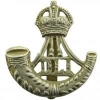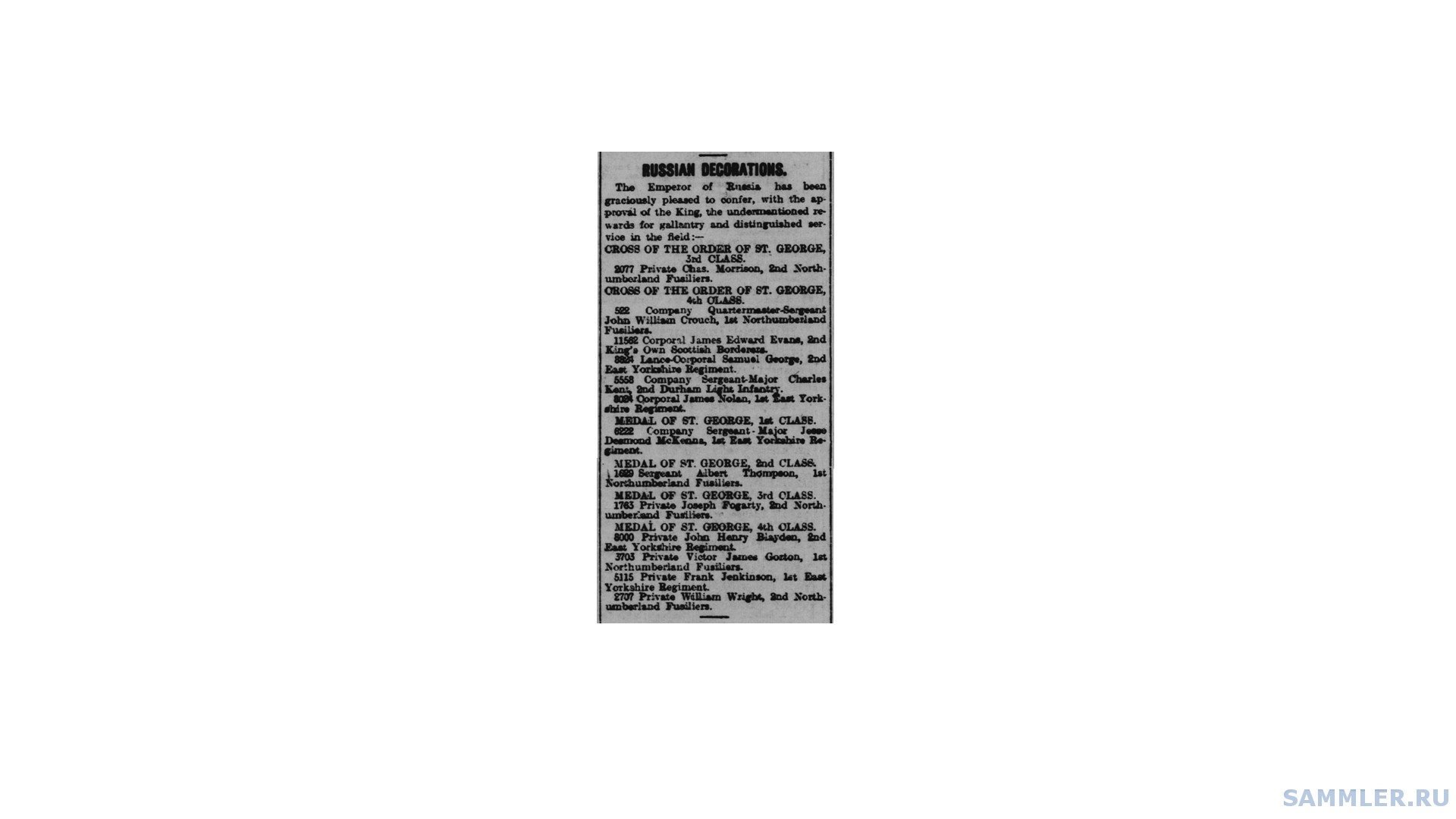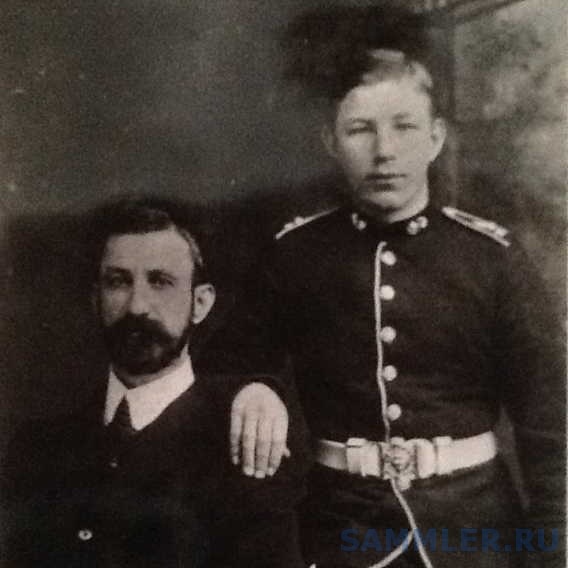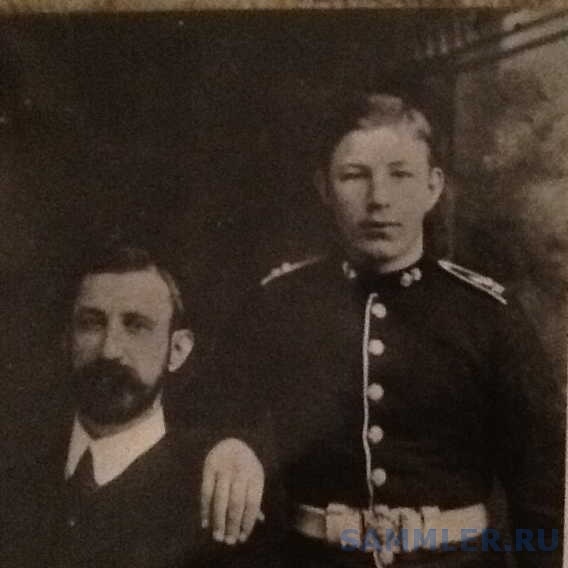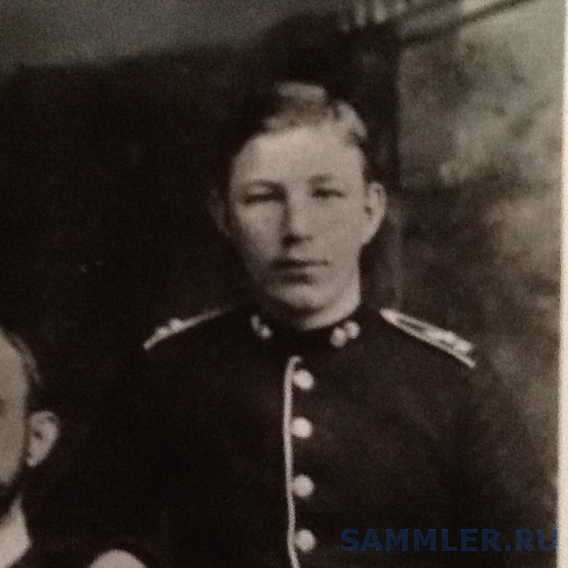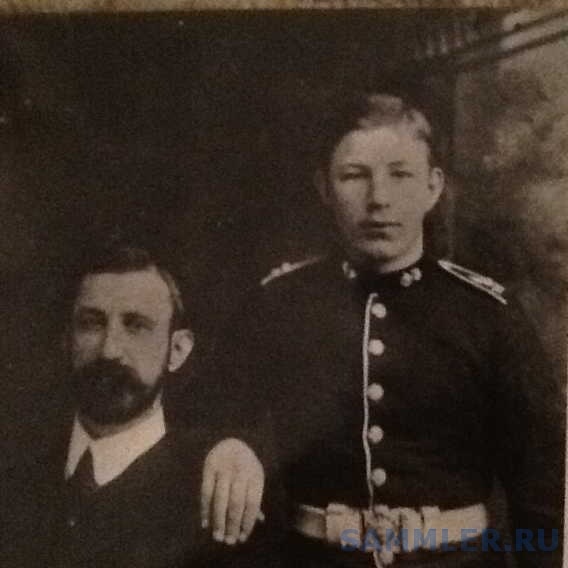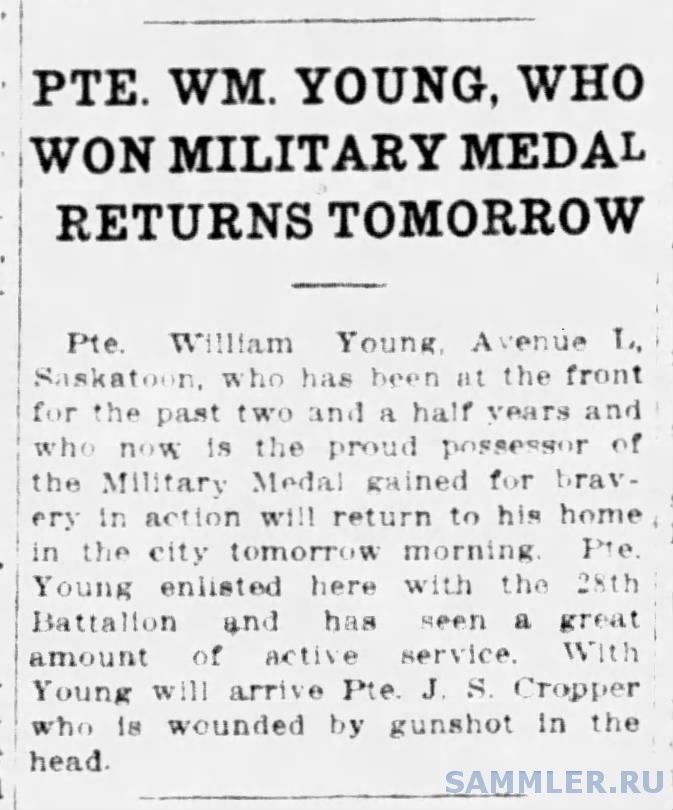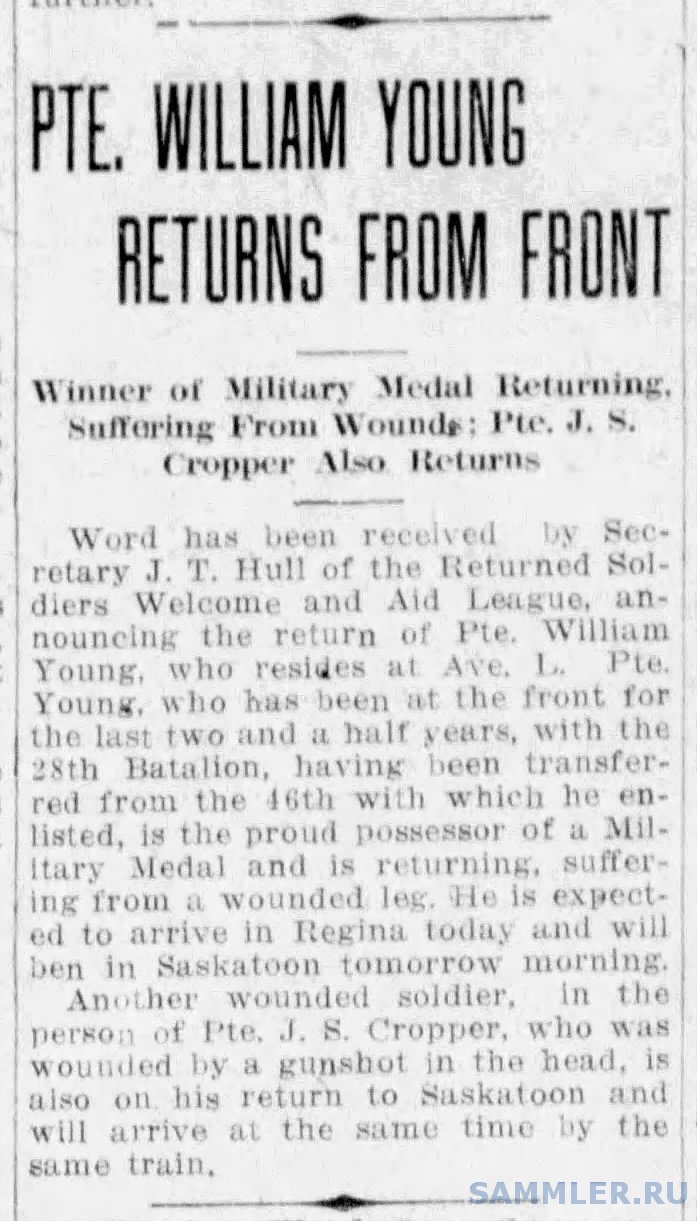-
Постов
80 -
Зарегистрирован
-
Посещение
Весь контент cmf
-
Just to touch upon something mentioned by Alexey above, the rank of 'Trooper' was, despite long, long use as a descriptive term for an ordinary cavalryman (by both civilians and soldiers alike), only officially adopted in the aftermath of the Second Anglo-Boer War, and then only for Privates of the 'Household Cavalry' (i.e. '1st Life Guards', '2nd Life Guards', and the 'Royal Horse Guards [The Blues]'). Privates of Line Cavalry and Yeomanry regiments were only redesignated with the rank title of 'Trooper' in 1921. A large part of the reticence to adopt the rank title of 'Trooper' stemmed from the fact that a 'Trooper' had long been the official designation for a cavalry Private's or N.C.O.'s mount, in the same way a cavalry officer's mount was referred to as a 'Charger'. Chris
-
786 Squadron, R.A.F., was a raised as a ‘Ground Defence’ squadron in July, 1941, based at the Royal Air Force’s ‘Aeroplane and Armament Experimental Establishment’ at Boscombe Down, in Wiltshire. In February 1942, all ‘Ground Defence’ squadrons were transferred to the newly formed ‘R.A.F. Regiment’, and were renumbered, 2000 being added to their existing numbers. In May 1943, 2786 Sqn converted to the light anti-aircraft role, and in June 1943 the unit was posted to Netheravon, in Wiltshire. After various other changes in location during 1943-44, the unit was converted to a rifle squadron in September 1944. The Squadron crossed to Belgium in April 1945, and into Germany the same month. By January 1946, the Squadron was based at Blankenese in Hamburg, with detachments at Louvaine, Ghent, Emsen, and Uetersen. At Lüneburg , in August 1947, 2786 Sqn was renumbered as 57 Sqn. The unit was finally disbanded at Gütersloh, North Rhine-Westphalia, in September 1957. Chris
-
Just a few details of Michael Doyle's service . . . 1831 - Michael Doyle is born in the parish of Trim, County Meath, Ireland. 05/11/1846 - Michael Doyle enlists into the 33rd (The 1st Yorkshire, West Riding) Regiment of Foot, at the county town of Mullingar, County Westmeath, Ireland, aged 15 years. 10/08/1847 – 2259 Private Michael Doyle, 33rd (The 1st Yorkshire, West Riding) Regiment of Foot, is appointed ‘Drummer’. 21/05/1848 - 2259 Private Michael Doyle, 33rd (The 1st Yorkshire, West Riding) Regiment of Foot, ceases to hold the appointment of ‘Drummer’. 02/09/1848 - 2259 Private Michael Doyle, 33rd (The 1st Yorkshire, West Riding) Regiment of Foot, is tried by Regimental Court Martial for being absent without leave, and is sentenced to 30 days imprisonment with hard labour. 17/05/1850 - 2259 Private Michael Doyle, 33rd (The 1st Yorkshire, West Riding) Regiment of Foot, is tried by District Court Martial for insubordination, and is sentenced to three months’ imprisonment with hard labour. 25/05/1868 - 2259 Private Michael Doyle, 33rd (The 1st Yorkshire, West Riding) Regiment of Foot, volunteers for, and is transferred to, the 2nd Battalion, 19th (The 1st Yorkshire North Riding) Regiment of Foot. 03/09/1869 - 1998 Private Michael Doyle, 2nd Battalion, 19th (The 1st Yorkshire North Riding) Regiment of Foot, is awarded the ‘Army Long Service and Good Conduct Medal’. 28/02/1871 - 1998 Private Michael Doyle, 2nd Battalion, 19th (The 1st Yorkshire North Riding) Regiment of Foot, is discharged at his own request, qualifying for pension after 21 years’ service. On discharge, Private Doyle had served 24 years, three months and 22 days. Up to 20/10/1870, and the date of the Regimental Board convened at Calcutta to consider his request for discharge, Private Doyle had served abroad for 15 years and ten months: 2 years, four months in the ‘Eastern Campaign’; three months in Mauritius; and 13 years and three months in India and Abyssinia. The character and conduct of Private Doyle was assessed as “Very Good. In possession of four ‘Good Conduct’ badges. In possession of the Crimean Medal - Alma, Inkerman and Sebastopol clasps; Turkish Medal; Abyssinian Medal; and the medal for ‘Long Service and Good Conduct’”. Private Doyle had received no injury during his period of service. His intended place of residence after discharge was Dublin, Ireland.
-
Hi all, Another interesting chap, a pre-war regular who timed it just right to spend most of his Army Reserve service on active duty !! June 1888 - William Morran born in the market town of Strathaven, in the civil parish of Avondale, County of Lanark (ie Lanarkshire), Scotland. Son of Andrew Owen Morran, a coachbuilder, and Jessie Morran ( née Wilson). 24/07/1907 - William Morran enlists at Glasgow into the 'Royal Horse Artillery & Royal Field Artillery' branch (RH & RFA) of the 'Royal Regiment of Artillery', on a 'Short Service' attestation, ie 6 years with the 'Colors', and 6 years in the Army Reserve. At enlistment, he gives his occupation as 'Labourer'. At enlistment, William Morran stated current service with the 'Volunteer Force', namely the '1st Lanarkshire Royal Garrison Artillery (Volunteers)', headquartered in the County of the City of Glasgow. 31/07/1907 - 47413 Gunner William Morran, Royal Regiment of Artillery (RH & RFA), is posted to No. 3 Depôt, RFA, at Seaforth Barracks, Urban District of Waterloo with Seaforth, Lancashire. 17/10/1907 - 47413 Gunner William Morran, No. 3 Depôt, RFA, is posted to 72nd Battery, XXXVIII Brigade, RFA, 6th Division, Eastern Command, at the garrison town and Municipal Borough of Colchester, county of Essex. 13/04/1908 - 47413 Gunner William Morran, 72nd Battery, RFA, is awarded the Third Class Certificate of Education, on the recommendation of an Inspector of Army Schools. 05/26/1908 - 47413 Gunner William Morran, 72nd Battery, RFA, is posted to 99th Battery, XX Brigade, RFA, 4th Division, Eastern Command, at Colchester. 17/09/1908 - 47413 Gunner William Morran, 99th Battery, RFA, embarks for service in India, and is posted to 25th Battery, XLVI Brigade, RFA, Jubbulpore Brigade, 5th (Mhow) Division, Southern Army, British Army in India ... The Battery is stationed at Kamptee Cantonment, Nagpur District, Central Provinces, British India. In December, 1908, XLVI Brigade, RFA, joined the Nasirabad Brigade of the 5 th (Mhow) Division, and the 25th Battery moved to Neemuch Cantonment, in the Mandasor District of Gwalior State (a semi-autonomous 'princely state', under the political supervision of the 'Central India Agency', which answered directly to the Governor-General of India). 08/10/1910 - 47413 Gunner William Morran, 25th Battery, XLVI Brigade, RFA, is mustered in the rank of 'Driver'. In January, 1913, XLVI Brigade, RFA, was transferred to the 3rd (Lahore) Division of the Northern Army. Of the three batteries in the Brigade, two (including the 25th Battery) became divisional artillery, and were stationed at Lahore Cantonment, Lahore District, Lahore [Administrative] Division, Punjab Province, British India . On 01/08/1913, XLVI Brigade, RFA, is redesignated as XXXV Brigade, RFA 10/12/1913 - 47413 Gunner William Morran, 25th Battery, XXXV Brigade, RFA, qualifies as a 'Signaller'. 09/01/1914 - 47413 Gunner William Morran, 25th Battery, XXXV Brigade, RFA, disembarks at Portsmouth, United Kingdom, for transfer to the Army Reserve. 10/01/1914 - 47413 Driver William Morran, 25th Battery, XXXV Brigade, RFA, is transferred to Section 'B', Army Reserve. His conduct and character during his 'Color' service is described thus: “Very Good. Accustomed to the care of horses, and a good groom ”. 05/08/1914 - 47413 Driver William Morran, Royal Regiment of Artillery (RH & RFA), Section 'B', Army Reserve, is mobilized at Glasgow, and posted to 146th Battery, VI Reserve Brigade, RFA, No. 1 District, Scottish Command. The Brigade is based in Glasgow, at No. 6 Depôt, RFA 08/13/1914 - 47413 Driver William Morran, 146th Battery, VI Reserve Brigade, RFA, is posted to 67th Battery, I Brigade, RFA, Scottish Command, at Edinburgh. 18/10/1914 - 47413 Driver William Morran, 67th Battery, I Brigade, RFA, is posted to 5 B Reserve Brigade, RFA, Irish Command, at the artillery station and town of Ballincollig, Cork Rural District, County Cork. 29.12.1914 - 47413 Driver William Morran, 5 Brigade Reserve Bed and, the RFA, is posted to 367th Battery, CXLVI Brigade, the RFA, 28Th Division, stationed in the Municipal then Borough of Winchester,, Hampshire You. 18/01/1915 - 47413 Driver William Morran, 367th Battery, CXLVI Brigade, RFA, 28th Division, embarks with his Battery at Southampton on board the steamship SS Matheran , bound for the seaport of Le Havre, département of Seine-Inférieure, France ... 19/01/1915 - 47413 Driver William Morran, 367th Battery, CXLVI Brigade, RFA, 28th Division, disembarks with his Battery from SS Matheran , at Le Havre. On arrival in France, 28th Division became a formation of V Corps, Second Army, 'British Expeditionary Force' (BEF). 11/17/1915 - 47413 Driver William Morran, 367th Battery, CXLVI Brigade, RFA, 28th Division, BEF, embarks with his battery at the city and seaport of Marseilles, département of Bouches-du-Rhône, France, for the 'Mediterranean Expeditionary Force '(MEF) at Salonika, Macedonia region, Greece. On 19/10/1915, the 28th Division was ordered to prepare to embark for Salonika, where it would become a formation of the MEF All formations and units of the Division, except for XXXI and CXLVI Brigades, RFA, sailed via Egypt, with all elements disembarked at Salonika by 04/01/1916. 11/29/1915 - 47413 Driver William Morran, 367th Battery, CXLVI Brigade, RFA, 28th Division, MEF, disembarks with his Battery at the city and seaport of Salonika. On 11/23/1915 the designation 'Mediterranean Expeditionary Force' ceased to be used for those British and Imperial formations serving in the Dardanelles and Salonika, the titles 'Dardanelles Army' and 'British Salonika Force' being substituted, respectively. The 28th Division would become a formation of XII Corps, and later XVI Corps, BSF 12/27/1916 - 47413 Driver William Morran, 367th Battery, CXLVI Brigade, RFA, 28th Division, BSF, is posted to 366th Battery, CXLVI Brigade, RFA (on the breaking up of 367th Battery). 11/03/1917 - 47413 Driver William Morran, 366th Battery, CXLVI Brigade, RFA, 28th Division, BSF, is awarded the 'Military Medal'. The award of the 'Military Medal' to Driver Morran, for 'bravery in the Field', was officially gazetted on 26/04/1917. Source: 'The London Gazette' (Fourth Supplement to issue of 24/04/1917) , no. 30036, 26/04/1917, p. 3947 08/13/1917 - 47413 Driver William Morran, MM, 366th Battery, CXLVI Brigade, RFA, 28th Division, BSF, embarks at Salonika with his Brigade, bound for the city and seaport of Alexandria, Egypt. In August 1917, CXLVI Brigade, RFA, left 28th Division, BSF, on the Brigade's transfer to the ' Egyptian Expeditionary Force' (EEF) . 17/08/1917 - 47413 Driver William Morran, MM, 366th Battery, CXLVI Brigade, RFA, EEF, disembarks at Alexandria. 09/21/1917 - 47413 Driver William Morran, MM, 366th Battery, CXLVI Brigade, RFA, EEF, is re-posted on the transfer of 366th Battery to CCLXVIII Brigade, RFA, 74th (Yeomanry) Division, EEF, and its redesignation as 'B' Battery. The '74th (Yeomanry) Division' was raised in Egypt during February 1917, as a 'Territorial Force' (TF) formation of the ' Egyptian Expeditionary Force' (EEF). The Division comprised three infantry brigades, formed from dismounted 'Yeomanry' regiments now serving as infantry battalions. From June 1917, the Division formed part of XX Corps, EEF In April 1918, CCLXVIII Brigade, RFA, was broken up, and 'B' Battery was transferred to CXVII Brigade, RFA, 74th (Yeomanry) Division, EEF, and resumed its designation as '366 th Battery'. At the end of April 1918, the 74th (Yeomanry) Division began embarking at Alexandria for Marseilles, having been transferred from the EEF to the BEF, for service on the Western Front. 02/05/1918 - 47413 Driver William Morran, MM, 366th Battery, CXVII Brigade, RFA, 74th (Yeomanry) Division, EEF, embarks at Alexandria, bound for Marseilles, France. 11/05/1918 - 47413 Driver William Morran, MM, 366th Battery, CXVII Brigade, RFA, 74th (Yeomanry) Division, BEF, disembarks at Marseilles. 01/07/1918 - 47413 Driver William Morran, MM, 366th Battery, CXVII Brigade, RFA, 74th (Yeomanry) Division, BEF, marries Elizabeth Taylor, a munitions factory worker, in Glasgow, during two weeks' furlough. 09/08/1918 - 47413 Driver William Morran, MM, 366th Battery, CXVII Brigade, RFA, 74th (Yeomanry) Division, BEF, is appointed Lance-Bombardier (paid). 16/01/1919 - 47413 Lance-Bombardier William Morran, MM, 366th Battery, CXVII Brigade, RFA, 74th (Yeomanry) Division, BEF, is transferred to the Georgetown (Paisley) Dispersal Unit, Scottish Command, for demobilization. 01/17/1919 - 47413 Lance-Bombardier William Morran, MM, Royal Regiment of Artillery (RH & RFA), Georgetown (Paisley) Dispersal Unit, Scottish Command, disembarks in the United Kingdom from France. 02/14/1919 - 47413 Lance-Bombardier William Morran, MM, Royal Regiment of Artillery (RH & RFA), Georgetown (Paisley) Dispersal Unit, Scottish Command, is transferred to Section 'B', Army Reserve, on demobilization. 23.07.1919 - 47413 Lance-Bombardier William Morran, MM, Royal Regiment of Artillery (RH & RFA), Section 'B', Army Reserve, is discharged on 'termination of first period of engagement'. 04/11/1943 - William Morran, MM, foreman at a steelworks, dies of pulmonary tuberculosis in the District of Provan, County of the City of Glasgow.
-
Hi t34, A similar enquiry regarding this medal appeared on another forum about 5 years ago . . . it was mentioned that the sales catalogue of the original auction where this was purchased in 2015, and the listing on ebay when the medal was subsequently sold again, described this decoration as being ‘engraved’ and ‘renamed’. 3/1077 Corporal, later Serjeant, Frederick S. Bloor, 1st Battalion, ‘The King’s Own (Yorkshire Light Infantry)’, first arrived in France & Flanders on 21/04/1915. He was wounded in October, 1915. He was discharged into the Class ‘Z’ Reserve on14/02/1919. I cannot find his name as a recipient of the M.M. in ‘The London Gazette’, nor does he appear in ‘For Bravery in the Field: Great War British Army Recipients of the Military Medal 1914-1920 - a Register’, published by Naval & Military Press. Chris
-
Thanks t34! A pleasure, as always! Each man's history is a new challenge, and these men deserve that their stories be told! Best wishes! Chris
-
Further to the information supplied by Alexey, I can offer a few more biographical details concerning 1763 Lance-Corporal Joseph Michael Fogarty, 2nd Battalion, The Northumberland Fusiliers. 25/09/1888 - Joseph Michael Fogarty is born in the Municipal Borough of Dublin, County Dublin, Ireland, son of Patrick Joseph Fogarty (1864-1918), and Mary Jane Fogarty (née Lowth) (1861-1900). 28/09/1888 – Joseph Michael Fogarty is baptised at the Parish Church of St Kevin, Municipal Borough of Dublin, County Dublin, Ireland. 31/03/1901 – At the Census of 1901 Joseph Michael Fogarty is listed as a ‘scholar’, living with his widowed father and siblings at 13 Ontario Terrace, Rathmines and Rathgar Urban District, County Dublin, Ireland. The occupation of Patrick Joseph Fogarty is given as ‘Assistant Clerk, National Education Office’. May 1906 - Joseph Michael Fogarty enlists into The Northumberland Fusiliers, at Dublin, and is posted to the 4th Battalion, stationed in the County Borough of Limerick, Ireland. The 3rd and 4th battalions of The Northumberland Fusiliers had been raised as additional regular units in 1900, as part of the expansion of the army during the Second Anglo-Boer War. Both were disbanded in 1907. With the abolition of the ‘Militia’ and ‘Volunteer Force’ units of infantry regiments in 1908, the designation of ‘3rd Battalion’ was adopted by the new ‘Special Reserve’ battalion of The Northumberland Fusiliers, and the title of ‘4th Battalion’ was now bestowed upon the senior ‘Territorial Force’ battalion of the regiment. Private Fogarty was likely posted to the 2nd Battalion just prior to the disbandment of the 4th Battalion, in Ireland, on 26th January 1907. Although Fogarty’s Service Record does not survive, the movement of 1762 Private George Barnard, 4th Battalion, The Northumberland Fusiliers, who enlisted in Dublin on 17th May, 1906, might serve as a guide to Fogarty’s service prior to the Great War: posted to 2nd Battalion, at Gravesend, November 1906; posted to the Regimental Depôt at Newcastle-upon-Tyne, June 1908; posted to 1st Battalion, October 1910, and embarked with battalion for India; posted to 2nd Battalion, in India, October 1913, when the battalions rotated; returned to United Kingdom with 2nd Battalion, December 1914. 17/01/1915 – 1763 Private Joseph Michael Fogarty, ‘A’ Company, 2nd Battalion, The Northumberland Fusiliers, 84th Infantry Brigade, 28th Division, V Corps, Second Army, British Expeditionary Force (B.E.F.), embarks with his battalion on board the troopship H.M.T. Australind at Southampton, bound for Le Havre, département of Seine-Inférieure, France. 18/01/1915 - 1763 Private Joseph Michael Fogarty, ‘A’ Company, 2nd Battalion, The Northumberland Fusiliers, B.E.F., disembarks from H.M.T. Australind at Le Havre. At some point between landing in France and May 1915, Private Fogarty was appointed Lance-Corporal. He was also a trained ‘Scout’, i.e. having had extra training in reconnoitring, observing, reporting techniques; such men had to be of good physique, intelligent, self-reliant, with good knowledge of concealment, map-reading, signalling, range-finding and all types of field-craft. There were two grades, ‘First Class Scout’, commonly called, in the infantry, a ‘Battalion Scout’, and ‘Second Class Scout’, usually referred to as a ‘Company Scout’. N.C.Os. and Men could qualify for both grades. These men did not form a separate section within an infantry battalion, and usually served as normal riflemen, only being called out when their skills were needed: nevertheless, there was a scout ‘structure’ within a battalion – one officer had the secondary responsibility of being ‘Scout Officer’, assisted by an N.C.O. scout, with each company of the battalion having five trained scouts (one N.C.O. and four Men). The N.C.O. acting as the assistant to the battalion’s ‘Scout Officer’ was expected to be a ‘First Class Scout’. 08/05/1915 - 1763 Lance-Corporal Joseph Michael Fogarty, ‘A’ Company, 2nd Battalion, The Northumberland Fusiliers, B.E.F., is reported missing, later presumed dead. On 8th May, 1915, 2nd Battalion, The Northumberland Fusiliers, was in the front line on the Frezenberg Ridge, a couple of miles north-east of Ypres. At 19:00, after a heavy bombardment, the Germans launched a large scale attack on the ridge, held by the British 27th and 28th Divisions. The 84th Infantry Brigade was pushed back, and the 2nd Battalion, North’d Fus, which was on the extreme left of the line held by 84th Brigade, was surrounded on three sides. The Commanding Officer of the battalion, Lieutenant-Colonel Enderby, and his Adjutant, Captain Auld, were captured. ‘B’, ‘C’ and ‘D’ companies were destroyed, as was No. 4 Platoon of ‘A’ Company. The remainder of ‘A’ Company held their ground: a German officer who demanded their surrender was shot dead by the Company Commander, Captain Hart, who himself was soon killed. The two remaining officers were wounded, so command of ‘A’ Company was now in the hands of its Serjeants. Early in the morning of 9th May, ‘A’ Company was relieved: 65 N.C.Os. and Men marched to the rear. ‘B’, ‘C’ and ‘D’ companies mustered only two officers and 51 N.C.Os. and Men between them. The battalion reported 12 killed, 126 wounded and 284 missing, for the action on the 8th May. However, those listed as killed were only those of the three surviving platoons of ‘A’ Company, as were the majority of the wounded, with the remainder made up of those wounded earlier in the action from the other companies, who it had been possible to evacuate. The Adjutant, Captain Auld, estimated that the number of men taken prisoner amounted to no more than 80, making it likely that about 200 of the men reported missing had also been killed. The action of the 8th May, 1915, is now designated the ‘Battle of Frezenberg’ (8th -13th May, 1915), and is considered a phase of ‘The Battle of Ypres, 1915’, commonly known as ‘Second Ypres’ (22nd April – 25th May, 1915). 25/08/1015 – 1763 Lance-Corporal Joseph Michael Fogarty, ‘A’ Company, 2nd Battalion, The Northumberland Fusiliers, B.E.F., is, with the approval of H.M. The King, conferred with the Medal of St George, 3rd Class, by H.I.M. The Emperor of Russia, ‘for gallantry and distinguished service in the Field’. Source: ‘The London Gazette’ (Second Supplement to issue of 24/08/1915), no. 29275, 25/08/1916, p. 8513 The family of Joseph Fogarty made enquiries to the British Red Cross & Order of St John, in September 1915, and January 1916, as to whether he had been captured and made a prisoner-of-war. A few years ago the great nephew of Joseph Fogarty made enquiries on another forum about his great uncle. He stated that the oral history in the family, as recounted by one of Joseph’s sisters, was that Joseph was a despatch rider, and that after the action of 8th May, 1915, only his ‘bike’ was found. Although the War Diary for the Headquarters of 84th Infantry Brigade mentions use of at least one motorcycle used for despatch, it’s unlikely an infantryman was trained upon, or employed, in such a rôle: motorcycles were used by despatch riders of the ‘Corps of Royal Engineers (Signals Service)’, ‘Army Service Corps (Motor Transport)’, and ‘Motor Machine Gun Service’ (before October 1915, part of the Royal Field Artillery). There were no motorcycles in the Transport Section of infantry battalions. It is much more likely that, if true, the family history is referring to a bicycle, which would fit in with Fogarty’s scouting rôle, and perhaps indicate a reconnaissance or despatch task he was undertaking at the time of his disappearance/death, for which his battalion recommended he receive the Medal of St George. The newspaper clipping below is from the ‘North-Eastern Daily Gazette’ of Thursday, 16th September 1915, p2, detailing the award of Russian decorations to men of northern English and southern Scottish regiments. I’ve also included some close-up views of the photograph posted by Alexey – a young Private Fogarty, circa 1906-07, in ‘Walking Out’ uniform, i.e. ‘Full Dress’ as worn in ‘Review Order’, but without ammunition pouch on waistbelt, and (out of sight here) the peakless, round, coloured ‘Forage Cap’ (known as the ‘Brodrick Cap’) worn in lieu of the ‘Full Dress’ head-dress, which for Fusilier ‘Other Ranks’ was the sealskin cap.
-
Hi t34, Another interesting character! Although I’ve pinned down the actual date of the action for which Young was decorated with the M.M., I’ve not been able to locate a citation in the available Battalion, Brigade or Divisional War Diaries. 15/09/1893 – William Young is born in the United Kingdom: according to his army service record, his place of birth was the County of Dumfries (i.e. Dumfriesshire), Scotland; according to his death registration, he was born in the County Borough of Liverpool, England. 17/06/1915 – William Young, a farmer, of Saskatoon, Province of Saskatchewan, enlists into the Canadian Expeditionary Force (C.E.F.) at Regina, Province of Saskatchewan, Dominion of Canada, and is posted to the 46th (South Saskatchewan) Battalion, C.E.F. with regimental number ‘A27294’ (the letter prefix later being changed to ‘4’). 04/09/1915 - 427294 Private William Young, 2nd Reinforcing Draft, 46th (South Saskatchewan) Battalion, C.E.F., embarks on board the troopship H.M.T. Missanabie at Montreal, Province of Quebec, bound for Plymouth, United Kingdom. Units of the C.E.F. still in training in Canada provided replacements to the C.E.F. in Europe through the system of ‘reinforcing drafts’. The 46th (South Saskatchewan) Battalion provided two such infantry drafts, in July and September of 1915, each draft comprising five officers and 250 ‘Other Ranks’. The remainder of the regiment finally embarked for the United Kingdom in October, 1915. 13/09/1915 – 427294 Private William Young, 2nd Reinforcing Draft, 46th (South Saskatchewan) Battalion, C.E.F., disembarks from the troopship H.M.T. Missanabie, at Plymouth. 14/09/1915 - 427294 Private William Young, 2nd Reinforcing Draft, 46th (South Saskatchewan) Battalion, C.E.F., is transferred to the 32nd Reserve Battalion, Canadian Training Division, C.E.F., at Shorncliffe Camp, County of Kent. 07/12/1915 - 427294 Private William Young, 32nd Reserve Battalion, Canadian Training Division, C.E.F., is transferred on draft to the 28th (Northwest) Battalion, 6th Canadian Infantry Brigade, 2nd Canadian Division, Canadian Corps, C.E.F. 08/12/1915 - 427294 Private William Young, 28th (Northwest) Battalion, C.E.F., arrives at the ‘Canadian Base Depôt’ (C.B.D.) at Le Havre, département of Seine-Inférieure, France. 24/12/1915 - 427294 Private William Young, 28th (Northwest) Battalion, C.E.F., leaves the ‘Canadian Base Depôt’ (C.B.D.) at Le Havre. 31/12/1915 - 427294 Private William Young, 28th (Northwest) Battalion, C.E.F., arrives at his Battalion, in the front line south of Ypres, Province of West Flanders, Belgium. 06/04/1916 – 427294 Private William Young, 28th (Northwest) Battalion, C.E.F., performs the action for which he receives the M.M. (date, but no other detail, is given in ‘Proceedings on Discharge’ completed in February 1917). On the night of 3rd an 4th April, 1916, the Canadian Corps relieved the British formations holding the front line at St Eloi, south of Ypres. A British subterranean mine, detonated on 27th March, had created a new topography between the two front lines, with seventeen new waterlogged craters superimposed on the old, the ground full of shell-holes and derelict trenches. As both sides vied for control of this broken ground, the Germans began a concentrated bombardment of the craters on the 4th & 5th April, killing hundreds of Canadian troops. However, this was only preparatory to a determined German attack on the 5th & 6th April, which pushed the Canadians back. The 28th (Northwest) Battalion was moved up from Brigade reserve to the centre of the support line, the shell-wrecked village of Voormezeele. Over the evening of the 6th April, and during the next day, the 28th Bn entered the craters and heroically counter-attacked, but failed to recapture the craters lost to the Germans. However, the Battalion formed attacking parties to reach isolated pockets of men from the other battalions of the 6th Brigade, who still held their ground. The units of the 6th Brigade, including the 28th Bn, were relieved on the 8th April. Ultimately, the Germans would control the craters until 1917. The intense action, lasting from the 27th March to 16th April, is now designated the ‘Actions of St Eloi Craters’. 30/06/1916 - 427294 Private William Young, 28th (Northwest) Battalion, C.E.F., is attached to a cable party of 2nd Canadian Divisional Signal Company, Canadian Engineers, C.E.F. 19/08/1916 - 427294 Private William Young, 28th (Northwest) Battalion, attached to a cable party of 2nd Canadian Divisional Signal Company, Canadian Engineers, C.E.F., ceases to be attached, and rejoins his Battalion. 15/09/1916 - 427294 Private William Young, 28th (Northwest) Battalion, C.E.F., is severely wounded in action at Courcelette, département of the Somme, France. He sustains a gunshot wound in the left leg, the bullet entering the thigh and exiting above the knee, severing the external popliteal nerve, causing left foot drop. Subsequent to being wounded, Private Young spends one week in a Base Hospital at Camiers, département of Pas-de-Calais, France. 23/09/1916 – 427294 Private William Young, 28th (Northwest) Battalion, C.E.F., is evacuated to the United Kingdom. 24/09/1916 - 427294 Private William Young, 28th (Northwest) Battalion, C.E.F., is admitted to the King George Hospital, Metropolitan Borough of Lambeth, County of London, and simultaneously transferred to the ‘Canadian Casualty Assembly Centre’ (C.C.A.C.). The C.C.A.C. was established in the United Kingdom in May 1916 as a new unit, to which all C.E.F. casualties evacuated from the Western Front would be transferred on their admission to hospital. The size of the C.C.A.C. can be gauged from the fact that in October 1916 alone, 13,000 men were transferred into and out of the unit. 03/10/1916 - 427294 Private William Young, C.C.A.C., C.E.F., is seriously ill at the King George Hospital, and undergoes surgery: the lesion of the external popliteal nerve is sutured, and the leg then placed at rest. 11/10/1916 - 427294 Private William Young, C.C.A.C., C.E.F., is awarded the ‘Military Medal’ (M.M.) for ‘bravery in the field’ whilst serving with the 28th (Northwest) Battalion, C.E.F. Source: ‘The London Gazette’ (Second Supplement to issue of 10/10/1916), no. 29780, 11/10/1916, p. 9839 18/11/1916 – The award of the M.M. to 427294 Private William Young appears in Brigade Orders, 6th Canadian Infantry Brigade, abstracted from the 2nd Canadian Divisional Routine Orders of the same day. Source: War Diary, 6th Canadian Infantry Brigade, November 1916: Appendix 2, Brigade Orders, 18/11/1916. 21/12/1916 - 427294 Private William Young, M.M., C.C.A.C., C.E.F., is removed from the ‘Seriously Ill List’ at the King George Hospital. 01/01/1917 - 427294 Private William Young, M.M., C.C.A.C., C.E.F., is admitted to the ‘Canadian Convalescent Hospital’, Municipal Borough of Bromley, County of Kent. 02/01/1917 - 427294 Private William Young, M.M., C.C.A.C., C.E.F., is admitted to ‘Edmonton Military Hospital’, Edmonton Urban District, County of Middlesex. 03/01/1917 - 427294 Private William Young, M.M., C.C.A.C., C.E.F., is admitted to the ‘Granville Canadian Special Hospital’, Municipal Borough of Ramsgate, County of Kent. 12/01/1917 –427294 Private William Young, M.M., C.C.A.C., C.E.F., is assessed by a Standing Medical Board at ‘Granville Canadian Special Hospital’, and his discharge from the C.E.F. is approved. 02/02/1917 - 427294 Private William Young, M.M., C.C.A.C., is discharged from Granville Canadian Special Hospital, Ramsgate, and transferred to the ‘Canadian Discharge Depôt’, (C.D.C.) preparatory to repatriation to Canada for discharge from the C.E.F. 02/02/1917 - 427294 Private William Young, M.M., C.D.C., C.E.F., embarks on board the troopship H.M.T. Missanabie, bound for Canada. 11/02/1917 - 427294 Private William Young, M.M., ‘H’ Unit, Military Hospitals Commission of Canada (M.H.C.C.), is at St Chad’s Convalescent Home, No. 12 Military District, Regina, Province of Saskatchewan, Dominion of Canada. 11/06/1917 - 427294 Private William Young, M.M., ‘H’ Unit, M.H.C.C., is assessed by a Medical Board held at Moose Jaw, Province of Saskatchewan, as being physically fit for overseas service, Class A3. Private Young had regained sensation in his left leg during March, 1917. 18/06/1917 - 427294 Private William Young, M.M., ‘H’ Unit, M.H.C.C., is transferred to the ‘95th Saskatchewan Rifles’, Canadian Defence Force (C.D.F.), and is posted to the regiment’s ‘C.E.F.’ Company at Regina, Saskatchewan. In April 1917, the Canadian government reorganised the home defence structure of the Dominion, with 48 existing regiments of the ‘Active Militia’ now becoming units of a new formation, the ‘Canadian Defence Force’ (C.D.F.). An active recruitment campaign was undertaken to enlist those men unable to volunteer for overseas service, and although offering a lower rate of pay, it was intended that in most other respects, such as terms of enlistment, uniform and equippage, the C.D.F. would mirror the C.E.F. 21/07/1917 - 427294 Private William Young, M.M., ‘C.E.F.’ Company, ‘95th Saskatchewan Rifles’, C.D.F., is transferred to the ‘Canadian Forestry Corps’ (C.F.C.), and posted to ‘No. 12 Forestry Draft’ at Prince Albert, Province of Saskatchewan. From July, 1917, each Military District within Canada was to form a C.F.C. Forestry Depôt Company, to train reinforcements for C.F.C. units in Europe. ‘No. 12 Forestry Draft’ was the single wartime reinforcement draft trained and despatched by the C.F.C. Forestry Depôt of No. 12 Military District (i.e. Province of Saskatchewan). 11/08/1917 - 427294 Private William Young, M.M., No. 12 Forestry Draft, C.F.C., embarks on board the troopship H.M.T. Grampian at Halifax, Province of Nova Scotia, Dominion of Canada, bound for Liverpool, United Kingdom. 23/08/1917 - 427294 Private William Young, M.M., No. 12 Forestry Draft, C.F.C., disembarks from the troopship H.M.T. Grampian, at Liverpool, and is posted to ‘Base Depôt C.F.C.’ (B.D.C.F.C.), C.E.F., Civil Parish of Sunningdale, County of Berkshire, United Kingdom. 21/09/1917 - 427294 Private William Young, M.M., B.D.C.F.C., C.E.F., is posted to No. 76 Company, No. 10 District, Marne Group, C.F.C., C.E.F., in France. 23/09/1917 - 427294 Private William Young, M.M., No. 76 Company, C.F.C., C.E.F., disembarks at Le Havre, département of Seine-Inférieure, France. 23/09/1917 - 427294 Private William Young, M.M., No. 76 Company, C.F.C., C.E.F., is appointed Acting Serjeant. 05/11/1917 - 427294 Private (A/Sjt) William Young, M.M., No. 76 Company, C.F.C., C.E.F., is deprived of the appointment of Acting Serjeant for being absent without leave. 16/11/1917 - 427294 Private William Young, M.M., No. 76 Company, C.F.C., C.E.F., is appointed Acting Corporal. 08/01/1918 - 427294 Private (A/Cpl) William Young, M.M., No. 76 Company, C.F.C., C.E.F., is deprived of the appointment of Acting Corporal for being absent without leave. 09/09/1918 - 427294 Private William Young, M.M., No. 76 Company, C.F.C., C.E.F., is punished with seven days’ ‘Field Punishment, No. 2’ for being absent without leave. 15/11/1918 - 427294 Private William Young, M.M., No. 76 Company, C.F.C., C.E.F., is granted 14 days’ leave to Paris. 29/11/1918 - 427294 Private William Young, M.M., No. 76 Company, C.F.C., C.E.F., rejoins his unit, from leave. 16/12/1918 - 427294 Private William Young, M.M., No. 76 Company, C.F.C., C.E.F., is posted to the ‘Base Depôt C.F.C.’ (B.D.C.F.C.), Civil Parish of Sunningdale, County of Berkshire, United Kingdom. 15/01/1919 - 427294 Private William Young, M.M., B.D.C.F.C., C.E.F., is attached to the ‘Canadian Concentration Camp’ (C.C.C.) at Kinmel Park, County of Clwyd, for repatriation to Canada. 15/02/1919 - 427294 Private William Young, M.M., B.D.C.F.C. attd. C.C.C., C.E.F., is transferred to Casualty Company, No. 12 Military District Depôt, Regina, Saskatchewan, Canada, and embarks on board the troopship H.M.T. Canada, bound for Halifax, Canada. 25/02/1919 - 427294 Private William Young, M.M., Casualty Company, No. 12 Military District Depôt, disembarks at Halifax, Canada. 18/03/1919 - 427294 Private William Young, M.M., Casualty Company, No. 12 Military District Depôt, is posted to the Discharge Section, No. 12 District Depôt. 19/03/1919 - 427294 Private William Young, M.M., Discharge Section, No. 12 Military District Depôt, is discharged from the C.E.F., being ‘Medically Unfit’ due to wounds. 21/02/1978 – William Young, M.M., dies of pulmonary oedema and viral pneumonia at Port Alberni, Province of British Columbia, Canada. 27/02/1978 – William Young, M.M., is cremated at Cedar, Province of British Columbia, Canada. The sources of the newspaper clippings below are, from left to right: 'The Saskatoon Daily Star' (Saskatoon, Saskatchewan, Canada) - Wed, 21 Feb 1917, p13 'The Saskatoon Phoenix' (Saskatoon, Saskatchewan, Canada) - Wed, 21 Feb 1917, p3
-
This is an example of the so-called ‘Moorfields Cross’, introduced in 1927, and awarded to nurses of the ‘Royal London Opthalmic Hospital’ (R.L.O.H.) upon the completion of their ophthalmic training. The cross seen here is of the ‘1st Type’, awarded from its creation to about 1933. The hospital, the first in the world devoted to the treatment of eye disease, was established in West Smithfield, London, in 1805, as the 'London Dispensary for Curing Diseases of the Eye and Ear'. In 1822, the institution moved to Lower Moorfields, London, and was retitled the ‘London Ophthalmic Infirmary’. The hospital received it’s Royal Charter from H.M. Queen Victoria in 1837, the year of her accession, and as a result was renamed the ‘Royal London Opthalmic Hospital’. In 1899, the hospital moved to Islington in London, although the hospital would continue to be commonly referred to as ‘Moofields’. After various amalgamations with other ophthalmic hospitals in London, ‘Moorfields’ became an institution of the National Health Service (N.H.S.) in 1948, and is now known simply as ‘Moorfields Eye Hospital’. Chris
-
An old thread I know, but the following information might be of interest. Further to the information supplied above regarding the ‘Silver War Badge’ (S.W.B.), there were two separate dies employed in its manufacture, and the badge in the photograph posted by Mikhail is of the earliest, or ‘Type I’, striking. The ‘Type I’ can be distinguished from the later type by the use of a horizontal pin (the ‘Type II’ having it vertical), smaller quatrefoils on the circlet, and a slight difference in the ‘I’ of the Royal and Imperial Cypher of the King-Emperor, George V. The issue of the S.W.B. was by application, and nominal rolls were kept of officers and men found eligible, which also recorded the number with which each badge was individually stamped. Therefore, we can identify the recipient of badge no. 28908 as one Alfred Ernest Lane, a cavalry N.C.O. who saw active service during the Second Anglo-Boer War, and in the first two years of the Great War. I’ve outlined his service history and other biographical details below. 07/02/1874 Alfred Ernest Lane is born in Catford, civil parish of Lewisham, county of Kent (Catford is now in Greater London, a district of the London Borough of Lewisham). Son of Thomas John Lane (1846-1915) (at the Census of 1881, a ‘Carman* & Contractor’, employing 9 men) and Louisa Anne, née Trew (1851-1889). * a driver of horse-drawn vehicles used for delivering goods. 08/02/1893 Alfred E. Lane enlists at St George's Barracks, Charing Cross, London, and attests into the ‘6th Dragoon Guards (Carabiniers)’ for a ‘Short Service’ engagement (7 years with the Colours, 5 years in the Reserve; or 8 years with the Colours, 4 years in the Reserve). At enlistment, gives his age as 19 years, and his ‘Trade or Calling’ as a ‘Pawnbroker’s Assistant’. 13/02/1893 3096 Private Alfred E. Lane, ‘6th Dragoon Guards (Carabiniers)’, joins his regiment at Piershill Barracks, Edinburgh. 31/05/1893 3096 Private Alfred E. Lane, ‘6th Dragoon Guards (Carabiniers)’, gains the 2nd Class Certificate of Education. 17/10/1893 3096 Private Alfred E. Lane, ‘6th Dragoon Guards (Carabiniers)’, fraudulently enlists, at Woolwich, into the Corps of Lancers of the Line, under the name of Alfred Bardrick. 18/10/1893 Alfred E. Lane is posted to ‘16th (The Queen’s) Lancers’, as 3670 Private Alfred Bardrick. 19/10/1893 Alfred E. Lane joins ‘16th (The Queen’s) Lancers’ at the Cavalry Barracks, Canterbury. 03/04/1894 Alfred E. Lane is detained in Guardroom for 10 days, awaiting trial. 13/04/1894 Alfred E. Lane is tried and convicted of fraudulent enlistment into ‘16th (The Queen’s) Lancers’. Imprisoned for 28 days. 11/05/1894 Alfred E. Lane is relegated to former Corps, and returned to duty as 3096 Private Alfred E. Lane, ‘6th Dragoon Guards (Carabiniers)’. 08/09/1896 3096 Private Alfred E. Lane, ‘6th Dragoon Guards (Carabiniers)’, is appointed Lance-Corporal. 12/11/1897 3096 Lance-Corporal Alfred E. Lane, ‘6th Dragoon Guards (Carabiniers)’, is promoted to the rank of Corporal. 11/05/1898 3096 Corporal Alfred E. Lane, ‘6th Dragoon Guards (Carabiniers)’, is appointed Lance-Serjeant. 30/05/1898 3096 Lance-Serjeant Alfred E. Lane, ‘6th Dragoon Guards (Carabiniers)’, passes Group I of the 1st Class Certificate of Education. 25/10/1898 3096 Lance-Serjeant Alfred E. Lane, ‘6th Dragoon Guards (Carabiniers)’, gains the 1st Class Certificate of Education. 01/04/1899 3096 Lance-Serjeant Alfred E. Lane, ‘6th Dragoon Guards (Carabiniers)’, is promoted to the rank of Serjeant. 03/11/1899 3096 Serjeant Alfred E. Lane, ‘6th Dragoon Guards (Carabiniers)’, embarks with half of his regiment, and the regimental H.Q., on S.S. Wakool at Tilbury Docks, London, bound for Cape Town, Cape Colony. 28/11/1899 3096 Serjeant Alfred E. Lane, ‘6th Dragoon Guards (Carabiniers)’, disembarks from S.S. Wakool at Cape Town, Cape Colony. During the Second Anglo-Boer War, 6 D.G. formed part of the 1st Cavalry Brigade, fighting with distinction at the Relief of Kimberley and Battle of Paardeberg (both February, 1900), Battle of Driefontein (March, 1900) and on operations in the Transvaal throughout 1901. 19/12/1900 3096 Serjeant Alfred E. Lane, ‘6th Dragoon Guards (Carabiniers)’, embarks on the R.M.S. Kinfauns Castle, bound for Southampton. 05/01/1901 3096 Serjeant Alfred E. Lane, ‘6th Dragoon Guards (Carabiniers)’, disembarks from R.M.S. Kinfauns Castle at Southampton. 11/03/1901 3096 Serjeant Alfred E. Lane, ‘6th Dragoon Guards (Carabiniers)’, embarks with drafts from his own and other cavalry regiments, on the S.S. Englishman at Royal Albert Docks, London, bound for Cape Town, Cape Colony. 10/04/1901 3096 Serjeant Alfred E. Lane, ‘6th Dragoon Guards (Carabiniers)’, disembarks from S.S. Englishman at Port Elizabeth, Cape Colony. 29/07/1902 3096 Serjeant Alfred E. Lane, ‘6th Dragoon Guards (Carabiniers)’, extends his service to complete 12 years with the Colours. 16/08/1902 3096 Serjeant Alfred E. Lane, ‘6th Dragoon Guards (Carabiniers)’, embarks with regiment on S.S. Ionian at Natal, Colony of Natal, bound for Madras, en route to new station at Bangalore, Mysore State, Indian Empire. 31/08/1902 3096 Serjeant Alfred E. Lane, ‘6th Dragoon Guards (Carabiniers)’, disembarks with regiment at Madras, Madras Presidency, Indian Empire. 12/12/1902 3096 Serjeant Alfred E. Lane, ‘6th Dragoon Guards (Carabiniers)’ marries Emilee Edith Westcott (1881-1929), at Colaba, Bombay Presidency, Indian Empire. 22/02/1904 3096 Serjeant Alfred E. Lane, ‘6th Dragoon Guards (Carabiniers)’, re-engages for the Corps of Dragoons of the Line “. . . for such time as shall complete 21 years service”. 30/08/1905 3096 Serjeant Alfred E. Lane, ‘6th Dragoon Guards (Carabiniers)’, completes course of instruction at the School of Musketry, Bellary, Madras Presidency, Indian Empire, with his attainment graded as ‘Distinguished’. 29/04/1906 3096 Serjeant Alfred E. Lane, ‘6th Dragoon Guards (Carabiniers)’, is promoted to the rank of Squadron-Quartermaster-Serjeant. 02/08/1906 3096 Squadron-Quartermaster-Serjeant Alfred E. Lane, ‘6th Dragoon Guards (Carabiniers)’, is granted 6 months furlough in the United Kingdom. 28/12/1906 3096 Squadron-Quartermaster-Serjeant Alfred E. Lane, ‘6th Dragoon Guards (Carabiniers)’, is granted 6 months extension to his furlough in the United Kingdom. 01/05/1907 3096 Squadron-Quartermaster-Serjeant Alfred E. Lane, ‘6th Dragoon Guards (Carabiniers)’, is attached to the Permanent Staff of the ‘Fifeshire and Forfarshire Imperial Yeomanry’, at Kirkcaldy, county of Fife, in the rank of Squadron-Quartermaster-Serjeant. He remains on the strength of the ‘6th Dragoon Guards (Carabiniers)’ as a supernumerary. 01/04/1908 3096 Supernumerary Squadron-Quartermaster-Serjeant Alfred E. Lane, ‘6th Dragoon Guards (Carabiniers)’, ceases his attachment to the Permanent Staff of the ‘Fifeshire and Forfarshire Imperial Yeomanry’, and is attached to the ‘3rd (Prince of Wales's) Dragoon Guards’, stationed at Aldershot, county of Hampshire. 31/10/1908 3096 Supernumerary Squadron-Quartermaster-Serjeant Alfred E. Lane, ‘6th Dragoon Guards (Carabiniers)’, ceases his attachment to the ‘3rd (Prince of Wales's) Dragoon Guards’, and is re-posted to the ‘6th Dragoon Guards (Carabiniers)’. He embarks with drafts from his own and other cavalry regiments, on H.M.T. Braemar Castle at Southampton, bound for Cape Town, Cape Colony, en route to his regiment’s station at Middelburg, Cape Colony. 22/11/1908 3096 Squadron-Quartermaster-Serjeant Alfred E. Lane, ‘6th Dragoon Guards (Carabiniers)’, disembarks from H.M.T. Braemar Castle at Cape Town, Cape Colony. 01/04/1912 3096 Squadron-Quartermaster-Serjeant Alfred E. Lane, ‘6th Dragoon Guards (Carabiniers)’, is awarded the ‘Army Long Service and Good Conduct Medal’. 19/12/1912 3096 Squadron-Quartermaster-Serjeant Alfred E. Lane, ‘6th Dragoon Guards (Carabiniers)’, embarks with regiment on S.S. Kildonan Castle at Durban, Province of Natal, Union of South Africa, bound for Southampton, en route to new station at Canterbury, United Kingdom. 11/01/1913 3096 Squadron-Quartermaster-Serjeant Alfred E. Lane, ‘6th Dragoon Guards (Carabiniers)’, disembarks from S.S. Kildonan Castle at Southampton, United Kingdom. 11/02/1914 3096 Squadron-Quartermaster-Serjeant Alfred E. Lane, ‘6th Dragoon Guards (Carabiniers)’, is permitted to continue in the service beyond 21 years. 15/08/1914 3096 Squadron-Quartermaster-Serjeant Alfred E. Lane, ‘6th Dragoon Guards (Carabiniers)’, embarks with regiment on the S.S. Teviot, bound for Rouen, département of Seine-Inférieure, France. 17/08/1914 3096 Squadron-Quartermaster-Serjeant Alfred E. Lane, ‘6th Dragoon Guards (Carabiniers)’, disembarks from the S.S. Teviot at Rouen. As a unit of the 4th Cavalry Brigade of the Cavalry Division (later retitled the ‘1st Cavalry Division’), 6 D.G. took part in the Battle of Mons during August, 1914, and the First Battle of the Marne in September. The 4th Cavalry Brigade then transferred to ‘2nd Cavalry Division’, with 6 D.G. subsequently seeing action at the First Battle of Ypres in October, 1914, the Battle Neuve Chapelle in March, 1915, and the Second Battle of Ypres in April, 1915. 01/08/1915 3096 Squadron-Quartermaster-Serjeant Alfred E. Lane, ‘6th Dragoon Guards (Carabiniers)’, reverts to the rank of Serjeant, at his own request. 16/09/1915 3096 Serjeant Alfred E. Lane, ‘6th Dragoon Guards (Carabiniers)’, embarks for the United Kingdom. 17/09/1915 3096 Serjeant Alfred E. Lane, ‘6th Dragoon Guards (Carabiniers)’, disembarks in the United Kingdom, and is posted to ‘No. 4 (Western) Cavalry Depôt’, at Newport. 24/10/1915 3096 Serjeant Alfred E. Lane, ‘6th Dragoon Guards (Carabiniers)’, is posted to the ‘3rd Reserve Regiment of Cavalry’, stationed at Canterbury. Raised in August, 1914, the 3rd Reserve Regiment of Cavalry was the training unit for the ‘3rd (Prince of Wales's) Dragoon Guards’, ‘6th Dragoon Guards (Carabiniers)’, ‘3/1st Northamptonshire Yeomanry’, ‘2/1st Surrey Yeomanry (Queen Mary's Regiment)’, and ‘1/1st Sussex Yeomanry’. 10/02/1917 3096 Serjeant Alfred E. Lane, ‘6th Dragoon Guards (Carabiniers)’, serving with ‘E’ Squadron, ‘3rd Reserve Regiment of Cavalry’, is ordered to his home address at 3 Norman Road, Canterbury, preparatory to discharge from the Army. 27/02/1917 3096 Serjeant Alfred E. Lane, ‘6th Dragoon Guards (Carabiniers)’, is discharged from the Army due to ‘Sickness’, as per paragraph 392 (xvi) of ‘The King’s Regulations and Orders for the Army, 1912’, being “No longer physically fit for War Service”. Total period of Army service: 24 years, 20 days. As of 18/12/1923, Alfred E. Lane is living at 22 Harrington Road, Leytonstone, Urban District of Leyton, country of Essex. As of 02/11/1929 (death of wife), Alfred E. Lane is living at 33 Market Place, Reading, county of Berkshire. As of 1939 Register, Alfred E. Lane is living with daughter, and her family, at 358 Peppard Road, Reading, county of Berkshire. 29/09/1959 Death of Alfred Ernest Lane, of 107 Connaught Road, Reading, Berkshire. 03/10/1959 Alfred Ernest Lane is cremated at Henley Road Crematorium, Caversham, county of Berkshire. Alfred E. Lane’s third and youngest child, First Radio Officer Kenneth Neville Lane, Merchant Navy, was killed on 23/03/1942, aged 30. His cargo ship, the S.S. Clan Campbell, was sunk after being attacked by Italian torpedo-bombers in the Mediterranean Sea, en route to Malta. Alfred E. Lane’s Medal entitlement (in order of wear): ‘Queen’s South Africa Medal’ (clasps: ‘Relief of Kimberley’; ‘Paardeberg’; ‘Driefontein’; ‘Transvaal’) ‘King’s South Africa Medal’ ‘1914 Star’ (clasp: ‘5th AUG.–22nd NOV. 1914’) ‘British War Medal 1914-1919’ ‘Victory Medal’ ‘Army Long Service and Good Conduct Medal’ Chris
- 4 ответа
-
- 1
-



